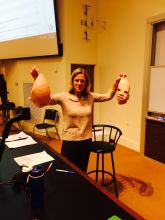Education
Teacher hypnotizes students, 1958
In 1958, Dr. David Briggs claimed that hypnotizing his students increased their academic performance by up to 15 percent.Reminded me of the Hypnotizing High School Principal I posted about back in October. The difference being that in the 1950s a professor hypnotizing his students was seen as a quirky but harmless experiment. But a principal who did essentially the same thing in the 21st Century got accused of contributing to the deaths of his students.

Newsweek - Apr 14, 1958

Valley Morning Star (Harlingen, Texas) - Apr 3, 1958
Posted By: Alex - Thu Dec 03, 2015 -
Comments (9)
Category: Education, Hypnotism, Mesmerism and Mind Control, Psychology, 1950s
Hypnotizing High School Principal

The case against Kenney is that the hypnosis may have been a causal factor in the deaths because it somehow messed up the fragile brains of the teenagers. Dr. Alan Waldman, a specialist in neuropsychiatry, testified that, "The wires that connect the neurons are still getting the fatty covering that insulates them. It doesn't stop forming till the early 20s. And they're a child's brain. That's a factor."
More info: gainesville.com, Huff Post.
Posted By: Alex - Sun Oct 11, 2015 -
Comments (5)
Category: Education, Hypnotism, Mesmerism and Mind Control, Psychology
Right to Compulsory Education
As far as I know, the terminology that compulsory education is a "right" continues to be used by international organizations, although it does sound vaguely Orwellian. The wikipedia page on Compulsory Education notes that the idea that children should be forced to go to school has a long history of controversy and has been criticized on the grounds that "it violates freedom and liberty" and that "it is slavery." However, pretty much every country in the world has some form of compulsory education.
The Daily Herald (Provo, Utah) - Apr 8, 1959
Posted By: Alex - Mon Sep 07, 2015 -
Comments (2)
Category: Education, 1950s
Sleep Learning
Learn to play the piano? In your sleep?

Source: The San Mateo Times - Aug 25, 1959
Posted By: Alex - Sun Jun 28, 2015 -
Comments (2)
Category: Education, Music, Sleep and Dreams, 1950s
Teaching history and science by dance
Marian Morgan believed that dance could be used to enhance the instruction of just about any subject. And back in 1916, she toured the country with her six dancers, demonstrating how dance-enhanced education would work.The basic theory was that students would pay more attention if young female dancers performed at the front of the classroom as the lecturer talked. For example, as explained by the Washington Post (Aug 20, 1916):
What happened? Has Old Bones (his disrespectful nickname for the professor of chemistry) been rooting around some second-hand store and found Aladdin's lamp?
The freshman's perception, newly acute, pierces his usual mental haze. The scene is a real one and delightful. True, 'Old Bones' is continuing his discourse. He is describing the chemistry of the blood. 'But this war of atoms may be a beneficent one,' he drones. 'The presence of disease-breeding bacilli in the blood is not necessarily destructive. For there are vigilant baccilli who lay hold upon the destroyers and slay them, as you see illustrated by this dance.'
The eyes of the freshmen beam. Never have 'Old Bones'' lectures been rewarded by such rapt and flattering attention. On the platform one lithe young Amazon in short Roman tunic is struggling with another.
Too bad this never caught on. Certainly would have improved a lot of lectures I had to sit through back in my college days.


Morgan's dancers
More in extended >>
Posted By: Alex - Mon Dec 22, 2014 -
Comments (9)
Category: Education, Universities, Colleges, Private Schools and Academia, 1910s, Dance
Follies of the Madmen #236
Posted By: Paul - Tue Nov 25, 2014 -
Comments (5)
Category: Business, Advertising, Products, Education, Stupidity, 1960s, Cars
Streakers Unmasked

Posted By: Alex - Wed Nov 05, 2014 -
Comments (9)
Category: Education, Universities, Colleges, Private Schools and Academia
Your Life Work: The Librarian
"Are books your friends?"
I don't believe the information sciences are much like this anymore.
Posted By: Paul - Sat Oct 18, 2014 -
Comments (5)
Category: Education, Books, 1940s
Empty Tank, Empty Head


Original article here.
Her obituary, curiously enough, makes no mention of this brush with fame.
Posted By: Paul - Mon Oct 13, 2014 -
Comments (3)
Category: Education, 1980s, Cars, Brain Damage
Follies of the Madmen #231
Posted By: Paul - Sat Oct 11, 2014 -
Comments (3)
Category: Anthropomorphism, Business, Advertising, Products, Education, 1970s

| Who We Are |
|---|
| Alex Boese Alex is the creator and curator of the Museum of Hoaxes. He's also the author of various weird, non-fiction, science-themed books such as Elephants on Acid and Psychedelic Apes. Paul Di Filippo Paul has been paid to put weird ideas into fictional form for over thirty years, in his career as a noted science fiction writer. He has recently begun blogging on many curious topics with three fellow writers at The Inferior 4+1. Contact Us |




